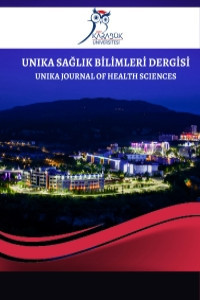Dental Asistanların Dental Materyaller ve Sterilizasyon Prosedürleri Hakkında Bilgi ve Farkındalık Düzeylerinin İncelenmesi
Amaç: Bu çalışmanın amacı, diş hekimliği kurumlarında görev yapan dişhekimi asistanları ile üniversitede öğrenim gören stajyer ağız ve diş sağlığı teknisyeni öğrencilerinin endodonti ve pedodonti malzeme ve ekipmanları ile sterilizasyon ve dezenfeksiyon işlemlerine yönelik bilgi düzeylerini ölçmektir. Yöntem: Çalışmaya kamu, özel ve üniversite kurumlarında çalışan, 18-65 yaş arası diş hekimliği asistanları ve üniversitelerin Ağız ve Diş Sağlığı Teknisyenliği Yüksekokulu öğrencilerinden oluşan 498 kişi katıldı. Katılımcılara yazılı bir anket uygulandı. Farklı sorulardan oluşan anket yardımıyla katılımcıların pedodontik ve endodontik materyaller ve sterilizasyon prosedürleri hakkındaki bilgi düzeyleri ölçüldü. Bulgular: Diş hekimi asistanlarının dental materyaller konusundaki bilgi düzeyleri katılımcıların %5,2'sinde düşük, %32,5'unda orta, %62,3'ünde ise yüksek bulundu. Asistanların bilgi düzeyleri ile cinsiyetleri (p=0,23), yaş grupları (p=0,09), eğitim durumları (p=0,41), mesleki tecrübeleri (p=0,51), sertifikaları (p=0,39) ve çalıştıkları kurum (p=0,24) arasında anlamlı bir fark bulunmadı. Sonuç: Diş hekimi asistanlarının pedodontik ve endodontik materyaller ile sterilizasyon prosedürleri hakkında bilgi eksikliklerinin olduğu tespit edildi. Hem yeni bilgilerin edinilmesi hem de mevcut bilgilerin tekrarlanması açısından eğitim programlarının planlanması ve düzenli olarak uygulanmasının diş hekimi asistanlarının eksikliklerinin giderilmesinde etkili olabileceği düşünülmektedir.
Anahtar Kelimeler:
Dental asistan, Endodontik materyal, Pedodontik materyal, Sterilizasyon
Evaluation of Awareness and Knowledge Levels of Dental Assistants on Dental Materials and Sterilization Processes
Objective: The aim of this study is to measure the knowledge level of materials and equipment for endodontics and pedodontics, as well as sterilization and disinfection procedures, of dental assistants in dental institutions and intern oral and dental health technician students studying at college. Methods: 498 people, including dental assistants working in public, private and university institutions, between the ages of 18-65, and students of the Oral and Dental Health Technician School of universities, participated in the study. A written questionnaire was applied to the participants. With the help of the survey consisting of different questions, the participants' knowledge levels about pedodontic and endodontic materials and sterilization procedures were measured. Results: The knowledge level of dental assistants about dental materials was found to be low in 5.2% of the participants, medium in 32.5% of the participants, and high in 62.3% of the participants. There isn’t any significant difference between the assistants' knowledge level and their gender (p=0.23), age group (p=0.09), educational status (p=0.41), professional experience (p=0.51), certification (p=0.39), and the institution that they work for (p=0.24). Conclusion: It was found that dental assistants have a lack of knowledge in this subject. It is thought that planning and perform regular training education programmes in terms of both acquiring new information and repeating existing information can be effective for eliminating the deficiencies of dental assistants.
Keywords:
dental assistant, endodontic material, pedodontics material, sterilization and disinfection,
___
- Aslam, A., Panuganti, V., Nanjundasetty, J. K., Halappa, M., & Krishna, V. H. (2014). Knowledge and attitude of endodontic postgraduate students toward sterilization of endodontic files: A cross-sectional study. Saudi Edu J, 4, 18-22. https://doi.org/ 10.4103/1658-5984.127982
- Azodo, C. C., Ezeja, E. B., & Ehizele, A. O. (2009). Factors influencing the selection of dental nursing as a profession. Benin Postgrad Med, 11, 27-36. https://doi.org/ 10.4314/bjpm.v11i1.48853
- Bagg, J., Sweeney, C. P., Roy, K. M., Sharp T., & Smith, A. (2001). Cross infection control measures and the treatment of patients at risk of Creutzfeldt Jakob disease in UK general dental practice. Br Dent J, 191(2), 87-90. https://doi.org/10.1038/sj.bdj.4801104
- Dental Assisting National Board. (2017). Meet state requirements. Retrieved from www.danb.org/Meet-State-Requirements.aspx. (Accessed date: 15 November 2017).
- Enabulele, J. E., & Omo, J. O. (2018). Sterilization in endodontics: Knowledge, attitude, and practice of dental assistants in training in Nigeria-A cross sectional study. Saudi Endod J, 8(2), 106-110. https://doi.org/ 10.4103/sej.sej5217
- Gutmann, M. E., & Gutmann, J. L. (1999). The dental hygienist as a co-therapist in the endodontic practice. J Endod, 25(4), 272-274. https://doi.org/10.1016/S0099-2399(99)80158-7.
- Khaki, N., Zarei, M., & Blookat, G. H. (2000). Evaluation of dental practitioner’s attitude toward infection control procedures in 1998. Journal of Shahid Beheshti Dental School, 19, 49-50.
- Kılıçarslan, M. A. (2013). Dört elli diş hekimliğinde yardımcı personel ve klinik yöntemi (ss. 10-34). Ankara: Palme Yayıncılık.
- Mahdipour, M., Zenouz, A. T., & Gholizadeh, N. (2007). Knowledge and Attitude of Dental Practitioners in Tabriz Regarding Infection Control Procedures. JODDD, 1, 103-117. https://doi.org/10.5681/joddd.2007.018
- Morison, S., Marley J, & Machniewski S. (2011). Educating the dental team: exploring perceptions of roles and identities. Br Dent J, 211(10), 477-483. https://doi.org/10.1038/sj.bdj.2011.963
- Mustafa, E. A., Humam, A. K., & Al Mosuli, T. A. (2015). Evaluation of dental assistant awareness concerning infection control policy of blood borne diseases. J Int Dent Med Res, 8, 21-24.
- Sarll, D. W., Jones, J. H., & Ashton M. A. (1996). Cross-infection control: the role of “in-training” dental nurses. Journal of Dentistry, 24, 349-353. https://doi.org/10.1016/0300-5712(95)00094-1.
- Sede, M. A., & Enabulele, J. E. (2015). Mercury hygiene and amalgam waste management: Knowledge and practice of trainee dental nurses. Ghana Dent J, 12, 12-14.
- Yusufoğlu, S. İ., & Ünsal, G. (2021). Diş Hekimi Asistanlarının Endodontik ve Protetik Materyaller Hakkındaki Bilgi Düzeylerinin Değerlendirilmesi: Anket Çalışması. Turkiye Klinikleri J Dental Sci, 27(1), 28-33. https://doi.org/10.5336/dentalsci.2019-72687
- Başlangıç: 2021
- Yayıncı: Karabük Üniversitesi
Sayıdaki Diğer Makaleler
Gebelikte D Vitamini Kullanımının Bebeklerin Kordon Kanında Vitamin D Düzeyine Etkisi
Mürvet Tuğba AYAN, Mehmet ÖZDEMİR, İsmail HASKUL
Hemşirelerin Çocuk İstismarı ve İhmalinin Belirti ve Risklerini Belirleme Durumları
Mihriban GÖKCEK, Neslihan YILMAZ ÇIRAKOĞLU
Sigarayı Bırakmada Vareniklin, Nikotin Replasmanı, Akupunktur. Hangi Yöntem, Ne Kadar Etkili?
Habibe İNCİ, Fatih İNCİ, Didem ADAHAN
Diz Osteoartritte Enjeksiyon Yöntemleri
Kerkük Şehrindeki Tip-2 Diabetes Mellitus Hastalarında Yaşam Kalitesi: Kesitsel Bir Çalışma
Ahmed Juneed Mohialdeen MOHIALDEEN, Jenan Akbar SHAKOOR, Ertan TAŞKINSEL, Fatih KARAYÜREK
